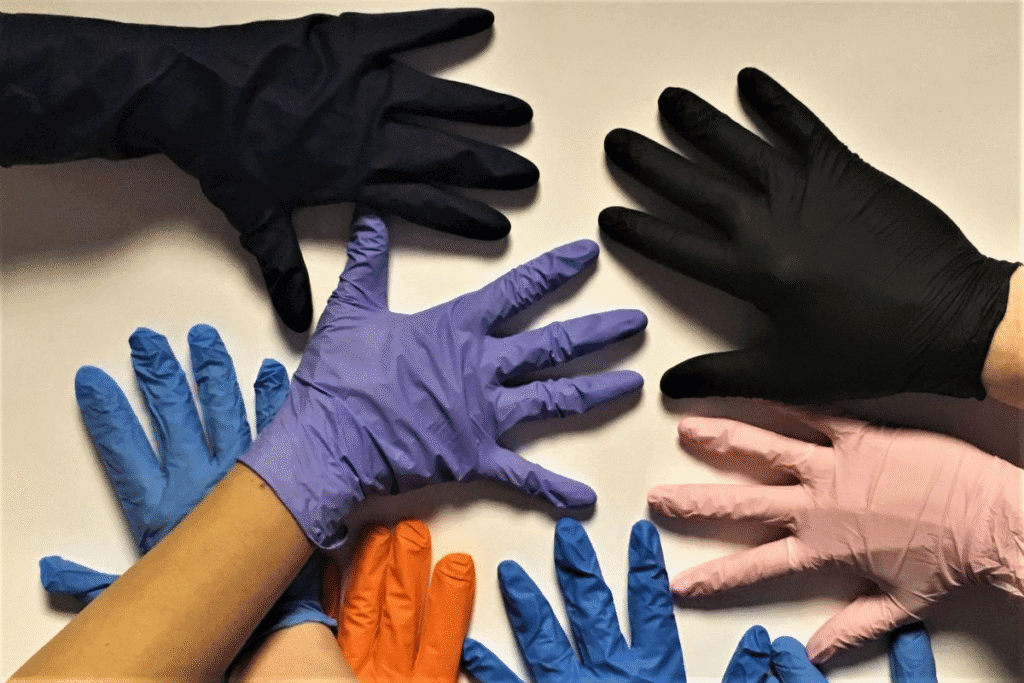Walk down the aisle of any safety supply store, and you’ll notice a clear price gap: vinyl gloves often cost half as much as nitrile gloves, if not less. This difference isn’t random—it stems from a mix of material costs, manufacturing complexity, performance trade-offs, and market dynamics. Let’s break down why vinyl gloves are the more budget-friendly option.
1. Raw Material Costs: Simple vs. Synthetic
At the heart of the price difference lies the cost of raw materials.
Vinyl gloves are made from polyvinyl chloride (PVC) resin, a widely produced plastic derived from vinyl chloride monomer. PVC is one of the most abundant polymers globally. In 2023, global PVC production reached over 58 million metric tons, according to the International PVC Manufacturers Association. This massive-scale production drives down costs. Manufacturers source it cheaply due to mature extraction and polymerization processes, and its chemical simplicity—composed primarily of carbon, hydrogen, and chlorine—requires minimal processing to transform into glove-grade material.
Nitrile gloves, by contrast, are made from nitrile rubber, a synthetic polymer formed by copolymerizing butadiene and acrylonitrile. These monomers are more expensive to produce and refine than vinyl chloride. Butadiene, for example, is often derived from petroleum, with prices tied to oil market fluctuations. The production of acrylonitrile requires energy-intensive chemical reactions to synthesize. Additionally, nitrile rubber production demands precise control over monomer ratios to achieve desired properties (like elasticity or chemical resistance), adding to raw material expenses.

2. Manufacturing Complexity: Speed vs. Precision
The way each glove is made further widens the cost gap.
Vinyl glove production is a streamlined process. Manufacturers dip molds into a liquid PVC mixture (resin blended with plasticizers, stabilizers, and pigments), then heat the molds to cure the material. This “dip molding” method is fast—production lines can churn out thousands of gloves per hour. In a typical vinyl glove manufacturing facility, a single production line can produce up to 5,000 gloves per hour, and it requires minimal labor or specialized equipment. The plasticizers added to vinyl (to make it flexible) are low-cost and easy to integrate, simplifying the manufacturing workflow.
Nitrile glove manufacturing is far more intricate. First, butadiene and acrylonitrile must be copolymerized under controlled temperature and pressure to form nitrile rubber latex—a step that demands precise chemical engineering. The latex is then mixed with additives (like vulcanizing agents to enhance durability and antioxidants to prevent degradation) before being used in dip molding. Nitrile also requires longer curing times and stricter quality checks to avoid defects like pinholes or uneven thickness, as its intended use (e.g., medical settings) demands higher reliability. These extra steps—longer production cycles, specialized machinery, and rigorous testing—drive up labor and energy costs.

3. Performance Trade-Offs: Functionality Dictates Value
Price often reflects performance, and gloves are no exception.
Vinyl gloves are functional but limited. They offer basic protection against water, mild detergents, and low-risk contaminants, making them suitable for tasks like food handling, janitorial work, or light assembly. However, they lack elasticity (feeling stiffer on the hand), have poor resistance to oils, solvents, or strong chemicals, and may degrade over time due to plasticizer migration. Their disposability and narrow use case mean manufacturers can’t justify premium pricing. A study by the American Society for Testing and Materials (ASTM) found that vinyl gloves failed puncture resistance tests at a rate 3 times higher than nitrile gloves when exposed to common sharp objects in a simulated work environment.
Nitrile gloves, on the other hand, are engineered for high performance. They boast excellent elasticity (fitting like a second skin), superior resistance to oils, acids, and alcohols, and greater durability—critical for medical procedures, industrial chemical handling, or laboratory work. Their ability to withstand harsh conditions and reduce allergy risks (unlike latex) makes them indispensable in high-stakes environments, allowing manufacturers to charge more for their enhanced functionality. In a chemical resistance test conducted by an independent research lab, nitrile gloves showed resistance to over 90% of common industrial chemicals, while vinyl gloves could only resist about 30% of the same chemicals.

4. Market Dynamics: Supply, Demand, and Competition
Market forces also play a role in pricing.
Vinyl gloves have been around for decades, with a well-established global supply chain. Countless manufacturers in regions like China, Southeast Asia, and Europe produce vinyl gloves, fostering intense competition that drives prices down. Their low barrier to entry—thanks to simple production methods—further saturates the market, keeping costs affordable. In fact, there are over 500 major vinyl glove manufacturers worldwide, flooding the market with an abundance of products.
Nitrile gloves, while now widely available, saw a surge in demand during the COVID-19 pandemic, straining supply chains. Even as production has ramped up, the specialized nature of nitrile manufacturing (fewer factories with the required expertise) limits competition compared to vinyl. Additionally, industries like healthcare and pharmaceuticals rely heavily on nitrile gloves, creating inelastic demand that supports higher prices. The healthcare industry alone accounted for over 60% of nitrile glove consumption in 2024, according to market research firm Statista.

Market Outlook for Vinyl and Nitrile Gloves
The future trajectories of vinyl and nitrile gloves are shaped by evolving regulations, consumer preferences, and industry needs:
- Vinyl Gloves: Their low cost ensures enduring demand in price-sensitive sectors, such as food service, retail, and basic cleaning. However, challenges loom: growing concerns over plasticizers (like phthalates) in vinyl—linked to health and environmental risks—have led to regulatory restrictions in regions like the EU and California. Manufacturers are responding by developing phthalate-free vinyl alternatives, but these may slightly raise production costs. Overall, vinyl gloves will retain a stronghold in low-risk, cost-driven markets but face pressure from eco-friendly alternatives. Market analysts predict that the demand for vinyl gloves in the food service sector will grow at a CAGR of around 3% in the next 5 years, mainly driven by the expansion of the fast-food and catering industries.
- Nitrile Gloves: Demand is projected to grow steadily, driven by expanding healthcare sectors in emerging economies and ongoing emphasis on infection control post-pandemic. Innovations like thinner yet durable nitrile formulations (reducing material use) and powder-free variants (to minimize irritation) will further solidify their position. While competition is increasing as more factories adopt nitrile production, their superior performance in high-risk settings (e.g., hospitals, chemical plants) ensures sustained premium pricing. Additionally, the shift away from latex gloves due to allergy concerns continues to benefit nitrile as a safer, versatile alternative. The global nitrile glove market is expected to reach a value of over $15 billion by 2030, growing at a CAGR of approximately 7% from 2025 to 2030, as forecasted by Grand View Research.
Comparison of Vinyl, Nitrile, and Latex Gloves

To better understand the unique roles of these three common glove types, here’s a detailed comparison across key metrics:
| Metric | Vinyl Gloves | Nitrile Gloves | Latex Gloves |
| Material | Polyvinyl chloride (PVC) with plasticizers. | Synthetic nitrile rubber (copolymer of butadiene and acrylonitrile). | Natural rubber latex from rubber trees. |
| Cost per Glove | 0.02–0.10 (most affordable). | 0.05–0.30 (mid-range). | 0.03–0.25 (varies by quality; often cheaper than nitrile but pricier than vinyl). |
| Elasticity & Fit | Low elasticity; stiff fit, may loosen during use. | High elasticity; snug, form-fitting (comparable to latex). | Excellent elasticity; tight, flexible fit (best for dexterity). |
| Chemical Resistance | Poor: Resists only 30% of common industrial chemicals (e.g., mild detergents). | Excellent: Resists 90%+ of industrial chemicals, oils, and solvents. | Good: Resists acids and alkalis but degrades in solvents like acetone. |
| Puncture Resistance | Low: 3x higher failure rate in ASTM puncture tests vs. nitrile. | High: Withstands sharp objects (e.g., needles, glass shards) better than vinyl. | High: Naturally resilient but less durable than nitrile in prolonged use. |
| Allergy Risk | Low: Rarely causes allergic reactions (phthalate-free variants further reduce risk). | Very low: Synthetic material, no latex proteins. | High: 1–6% of the general population is allergic to latex proteins (per FDA). |
| Primary Use Cases | Food handling, basic cleaning, low-risk retail tasks. | Medical procedures, industrial chemical handling, auto repair. | Medical surgeries (traditional choice), dental work (high dexterity needed). |
| Environmental Impact | High: Non-biodegradable; PVC production releases toxic byproducts. | Moderate: Non-biodegradable but recyclable in some facilities. | Lower: Renewable resource but requires deforestation for rubber tree plantations. |
Conclusion
The lower cost of vinyl gloves boils down to economics: cheaper raw materials, simpler manufacturing, limited performance, and a saturated market. Nitrile gloves, with their superior protection and versatility, command higher prices, while latex gloves remain a niche option due to allergy risks despite their dexterity.
Each type serves distinct needs: vinyl for budget-friendly, low-risk tasks; nitrile for high-stakes, chemical-heavy environments; and latex for specialized roles where elasticity and precision are paramount. As regulations and innovations evolve, these gloves will continue to adapt, but their core strengths—affordability, durability, and dexterity—ensure they’ll coexist in the market for years to come.


